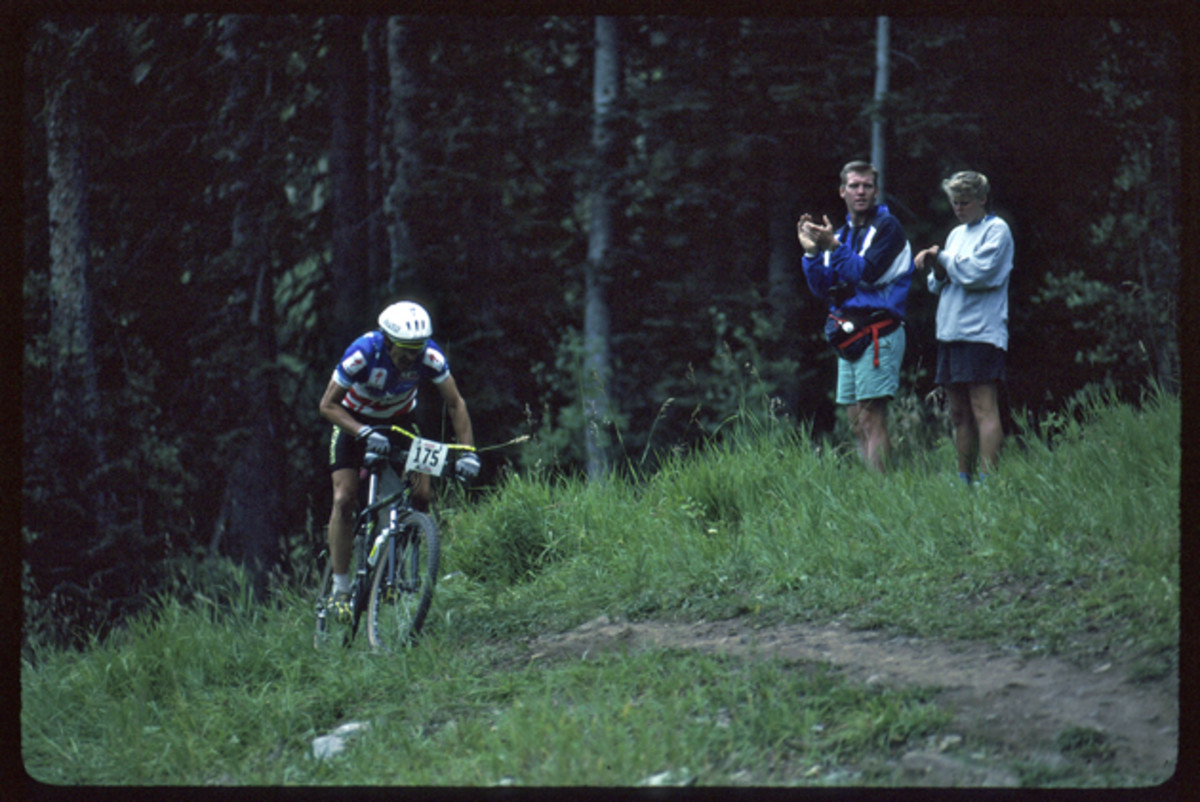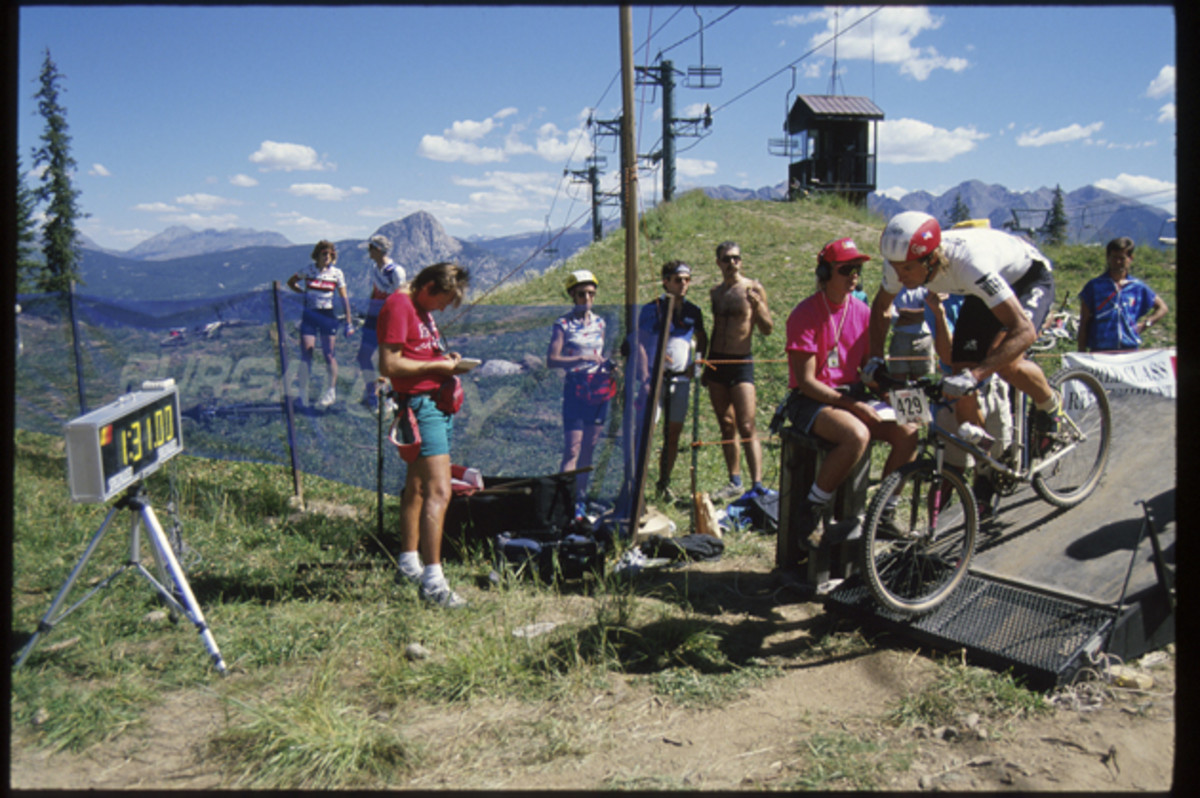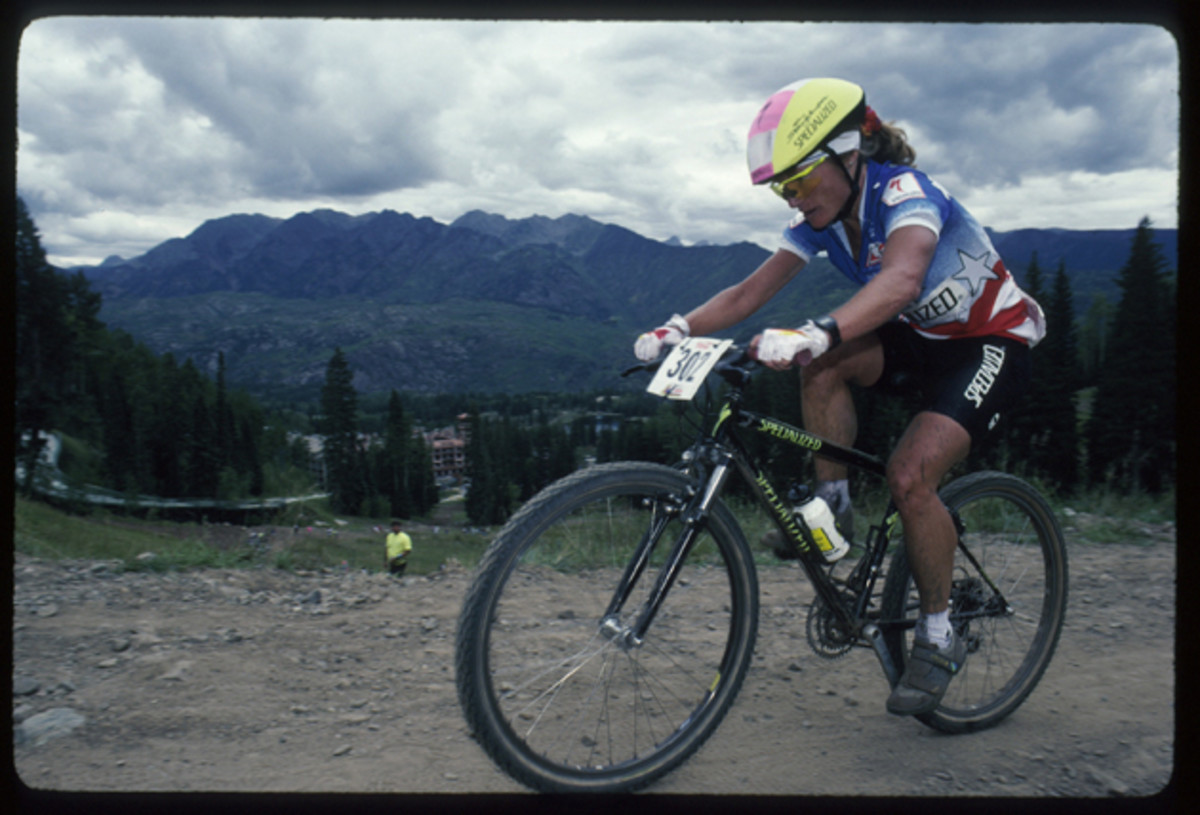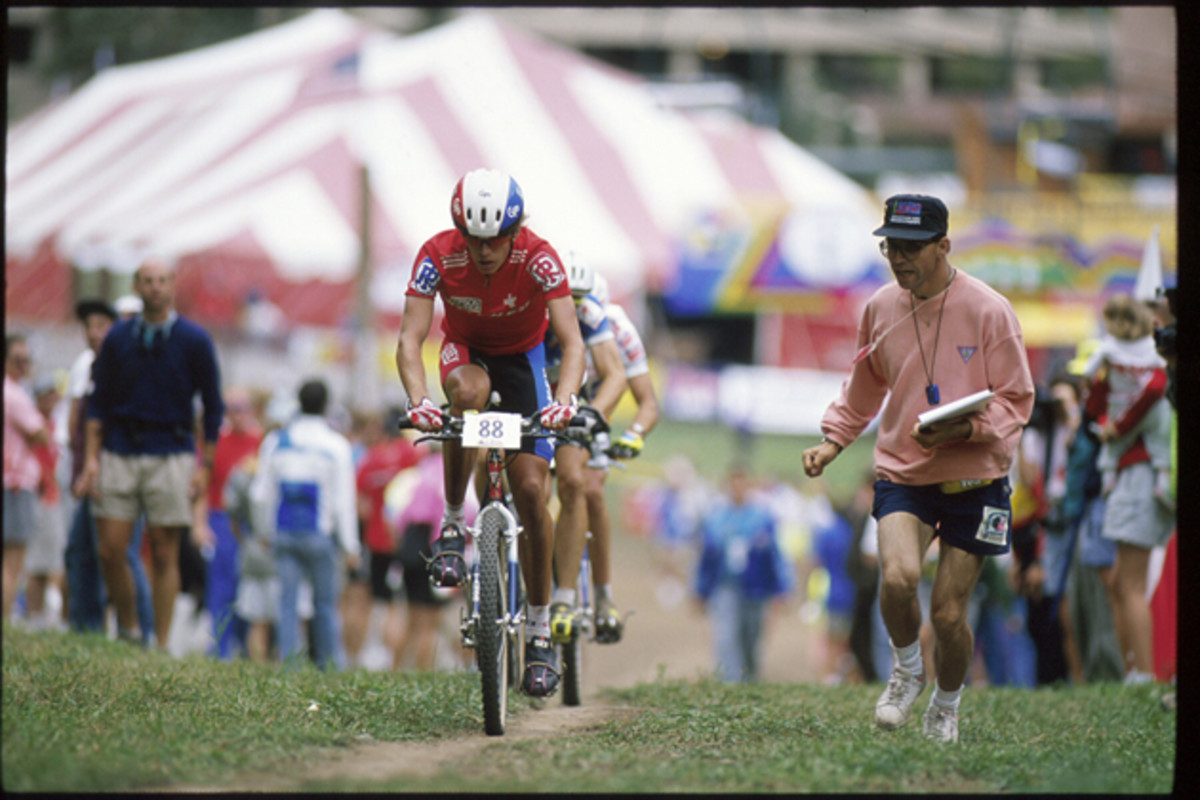Fat-tire birthday: Mountain biking's championships turn 25 years old

Happy anniversary, fat-tire types. The mountain bike—that wild-hair, American-made answer to the European cycling craze—finally got global recognition a quarter of a century ago, with the inaugural UCI Mountain Bike World Championships in 1990 in Durango, Colo.
This Saturday, Sept. 12, the 25th anniversary of that milestone will be recognized when mountain bike legend Ned Overend and former U.S. team member Todd Wells get together with more than 300 of their best knobby buddies for the Todd and Ned’s Durango Dirt Fondo in the dusty mountains of southwest Colorado.
“It was awesome to be a part of history,” says Juli Furtado, another renowned racer who won the 1990 women’s cross-country worlds (and won the downhill worlds in ’92) while riding for Yeti. “While I was new to the sport, I did know the significance of inaugural ‘official’ world championships. Everyone there knew it was the beginning of something special.”
Yes, cycling’s counter-culture revolution is now officially a quarter-century old. And, like many landmark moments, it gives folks—especially former racers—a chance to reflect on this decidedly American contribution to the bike-racing world. A quick peek reveals that mountain biking has undergone a seismic shift in the past 25 years, with myriad changes in rules, race formats, equipment, and sponsorship.
John Tomac, another Yeti rider in 1990, raced in both the cross-country and downhill events (the following year he won gold and silver in those two disciplines, respectively, in one of the great performances in Worlds history). His cross-country rig that day looked oddly out of place, with drop handlebars (like a road bike), bar-end shifters, and a solid disc rear wheel.
Mildon vs. Foster: The toll of landing the first-ever quad flip on a BMX bike
“When I first started racing in 1986, we had no disc brakes, no index shifting, no clipless pedals, and no suspension front or rear,” said Tomac. “As I finished my career in 2000, I had virtually the same downhill bike as the current guys use.”
Overend, a longtime Specialized-sponsored rider who still works and occasionally races for the manufacturer, won the inaugural cross-country championship riding a prototype frame featuring carbon tubes and titanium lugs, while most racers had aluminum bikes. Today, most top-end bikes have carbon frames.
“It turned out that that bike was so expensive to produce [that] it wasn’t commercially viable,” says Overend. “But it was a pretty light bike. The average hardtail back then probably weighed 22, 23 pounds. Today, bikes weigh 18, 19 pounds. If you figure percentage-wise, that’s a pretty big difference. Right now, you can get a full-suspension bike that weighs less than those old hardtails.”
Overand’s bike also featured toe clips and straps, a revolutionary RockShox RS-1 front suspension fork, and 26-inch wheels. Clipless pedals, first introduced by Shimano, and front suspension instantly became ubiquitous. Full-suspension soon took hold among downhillers, who didn’t have the same weight concerns as cross-country racers. Eventually, though, the technology brought full-suspension to the masses, and Switzerland’s Christophe Sauser won the 2008 world championships aboard a dual-suspension Specialized Epic. More recently, larger 29- and 27.5-inch wheels have become the standard.

“That 26-inch wheel is essentially obsolete in cross-country racing,” says Overend, noting Durango’s 25th anniversary party will also feature a vintage bike display.
On the downhill side, Greg (Hairball) Herbold, who topped the podium in 1990, says: “The bikes these days are amazing, especially compared to what I raced on. I feel lucky to have been a big part of the progress of the equipment. The level of technology and complexity is pretty mind-boggling. A modern factory DH bike has some of the most advanced suspension, brake, frame and wheel technology seen in any form of racing.”
Herbold’s memories of 1990 are still vivid.
“Racing in your hometown is always exciting, but filled with pressure,” says Herbold, who works for the component company SRAM. “Having an international field and lots of media attention, as well as many spectators, just gave the whole event a special feeling, and a feeling of being part of history. To say my life was forever changed because of that event would be a huge understatement.”
That “media attention” speaks to another shift in a sport that was on the cutting edge of the “extreme” movement (ESPN’s original X Games in 1995 had a downhill race at Vermont’s Mount Snow). For many mountain biking fans, the sport’s apex came in 1996, when cross-country was added to the Olympic schedule for the Atlanta Games.
“In those days, there was a lot of TV coverage and a lot of magazine coverage,” says Overend. “The advertising and promotion of mountain [biking] was predominantly through racing. But now, there’s a lot more focus on the travel and the recreational side of mountain biking.”

Conversely, downhill racing “is not an Olympic sport but still has a huge following, especially in Europe,” says Herbold.
“Companies like Red Bull have committed huge resources to both event and athletes, and the racers are free spirits risking life and limb on crazy steep and rough courses,” he adds. “The addition of events like Crankworx and slope-style contests bring a whole new level of skills and an injection of youth into the sport.”
Equipment and media coverage, however, aren’t the only aspects of the sport that have changed dramatically. The original cross-country races were epic challenges, with riders pedaling off into the wooded hillsides for 2½ to three hours. Riders weren’t allowed to accept outside help. If something broke, or you got a flat, you had to fix it yourself.
“One of the reasons I did well was my ability to set my bike up so that it was durable, and it lasted through the whole event,” says Overend. “And I could fix it if I needed to. Plus, I also rode with some finesse, so that I didn't trash my equipment. I thought those were a couple of my strong suits, and why I wasn't so much for [the rules change] then.”
Once the Union Cycliste Internationale (UCI) took over the world championships from the National Off-Road Bicycle Association (which later merged with USA Cycling), the sport, as many suspected, morphed into a more Euro-centric discipline. Cross-country courses today are shorter, designed for a TV-friendly 90-minute race while giving spectators a chance to see the competitors more often.
BMX rider Scotty Cranmer pushes to make a dangerous sport a little safer
“When you say spectator, what you’re saying is sponsorship,” says Overend. “It’s important for the riders to be able to make a living at this sport. So what’s good for the spectators and the sponsors also tends to be good for the riders.”
In the same vein, the racecourses now have pit stops, similar to cyclocross, and pit crews to solve mechanical issues. Even the old guard grudgingly acknowledges that those changes haven’t ruined the sport.
“I find the current style of World Cup racing very exciting to watch,” says Overend, 60. “And we have a different discipline now, which is marathon racing. So the old-style cross-country racing is now more similar to marathon racing.”
Unfortunately, the United States rarely has a racer in the medal hunt these days. The last American male to win a marquee race was downhiller Myles Rockwell in 2000, after Americans took three of the first four world downhills (Herbold in 1990, Dave Cullinan in ’92, and Mike King in ’93). Worse, male U.S. downhillers haven’t been back to the podium since Rockwell’s triumph, although Kathleen Pruitt brought home bronze in 2009.
In cross-country, U.S. men won the first two world championships (Overend in 1990, and Tomac in ’91), but haven’t captured gold in the 23 years since. Tinker Juarez came close in ’94 at Vail, but finished second to the Great Dane, Henrik Djernis (the first three-time winner). Canadian Roland Green represented North America with two gold medals in 2001 and 2002, but those were the last two gold medals for the continent on the men’s side. The last female to medal for the U.S. was Lea Davidson, who snagged cross-country bronze in 2014 (Catharine Pendrel of Canada won that year).

“We’ll never have the opportunity to make a podium because you almost have to make riding your lifestyle full-time in Europe,” says Juarez, 55. “It’s like that in road racing. In order to be any good on a road racing team, you have to be part of the European team.”
That speaks to the sport’s the fiscal reality, which has also changed substantially in the past two decades. During mountain biking’s boom, sponsors flocked to the sport, reflected in powerhouse teams such as Trek/Volkswagon and Volvo/Cannondale. Jeep sponsored the national race series, and even Ralph Lauren launched his own RLX cycling line.
Former pros all wax nostalgic about the financial windfall mountain biking represented in the 1990s.
“There was more money for rider salaries in those days,” says Overend. “Now, because the sport has expanded into enduro and short-track, cross-country, marathon, it’s harder for the rider to be focused and the sponsors’s dollars to be focused. Consequently, there’s less sponsorship for cross-country racers these days.”
Herbold agrees. “Guys like Ned and me were lucky to be involved in a new sport during the explosive popularity period,” he says. “It happens in all new sports.”
Says Herbold, “There may not be as many riders getting wealthy racing bikes, but the good ones still make tons, much of it from energy drink companies, camera companies, and even car companies still.”

Another stumbling block is the absence of youth cycling programs, since most tend to concentrate on the stick-and-ball sports, or traditional sports like track and field. That landscape, however, is evolving with the advent of the National Interscholastic Cycling Association (NICA), which was founded in 2009.
“The sport as a whole continues to grow,” says Mike Kloser, who took silver in the 1990 downhill. “One of the best programs mountain biking has going in the U.S. is the high school league. Both of my kids participated in the high school league and really enjoyed the series. It’s a bit like Little League baseball is for a developmental program.”
A recent high school race in Summit Country, Colo., drew roughly 800 competitors, says Overend. “What’s really important about it is the philosophy of NICA—that everybody rides,” he says. “They like to say, ‘There is no bench. There are no benchwarmers.’ It’s a great philosophy.”
“Europe has a better club system which attracts and develops junior racers,” says Overned. “So partly, it’s a matter of numbers and the level of competition, the cream rises to the top. I believe NICA high school racing will change this. We are already seeing former high school racers starting to appear on the podium at the elite and U23 level.”
The key for young racers is finding their niche, and finding financial support.
“Now you can find virtually any type of racing or event you would like to do,” says Tomac, 47. “You can do marathon races, 12- or 24-hour events, short track cross-country, normal cross-country racing, enduro or downhill racing. It’s all available.
“As far as professional racing goes, I’m not sure the hey-day of the early ’90s will ever be matched in mountain biking. There was just something really special about that time in out sport, a vibe and excitement that I haven’t seen since. I really feel that the Durango World Championships was a shining star from that bright period.”
